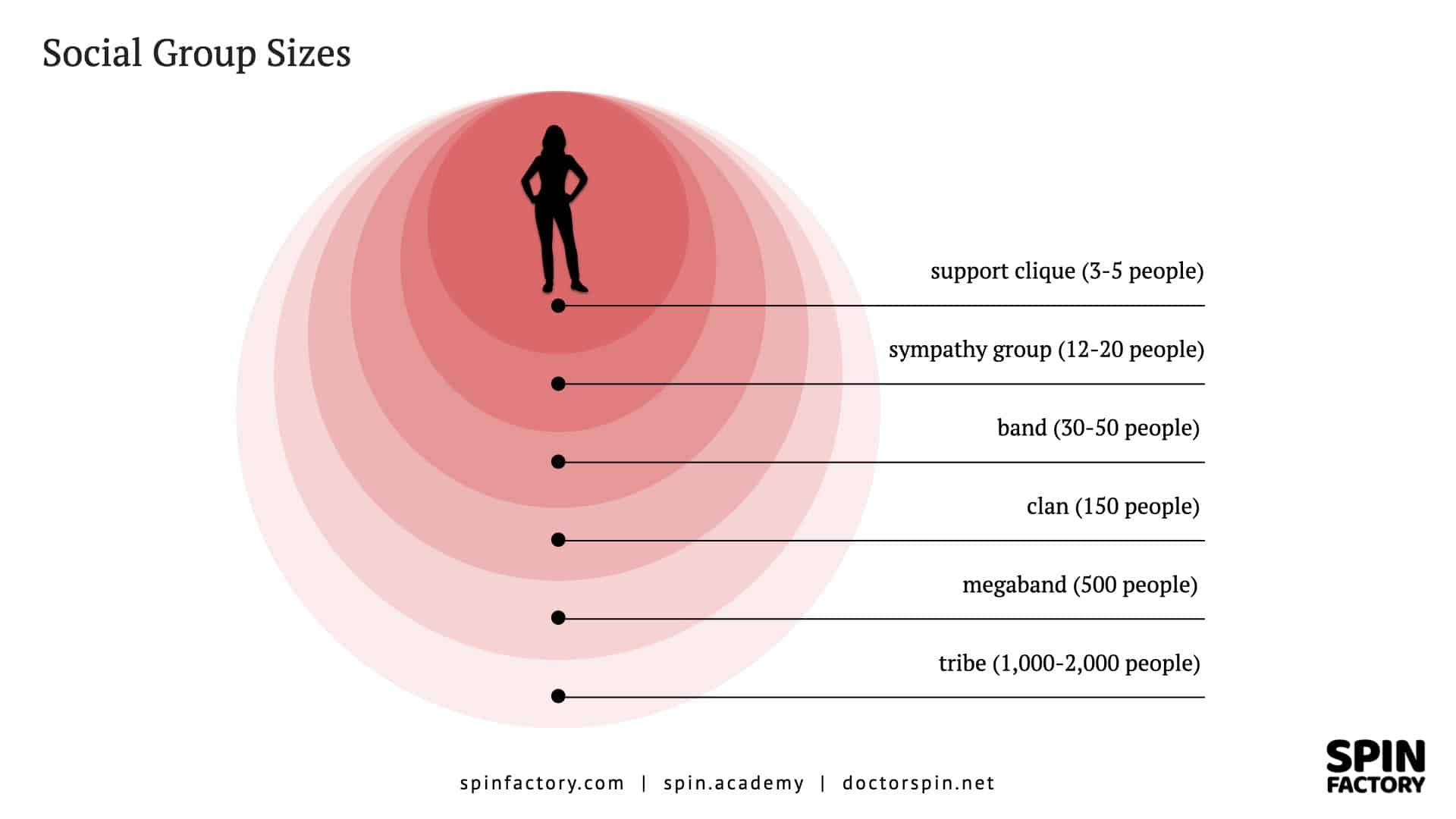“150” is often referred to as Dunbar’s Number.
Dunbar’s number has been observed in various aspects of human society. The group size suggests a cognitive limit for relationships.
The number 150 emerged from studies of social group sizes in various societies, as well as in non-human primates, and from the ratio of neocortical volume to the total brain size. 1Dunbar, R. I. M. (1992). Neocortex size as a constraint on group size in primates. Journal of Human Evolution, 22(6), 469 – 493.
For instance, military units have often been organized around this size, and some businesses have used it as a guide for structuring their organizations.
Here we go:
Dunbar’s Number: 150 Relationships

Spin Academy | Online PR Courses
150 — Dunbar’s Number
Robin Dunbar, a British anthropologist and evolutionary psychologist, proposed what’s known as “Dunbar’s Number” — a theory suggesting that humans can only comfortably maintain about 150 stable relationships. 2Dunbar, R. I. M. (1998). The social brain hypothesis. Evolutionary Anthropology: Issues, News, and Reviews, 6(5), 178 – 190.
This includes family, friends, colleagues, and others with whom a person can keep meaningful contact. Beyond this number, the quality of relationships can diminish due to the limitations in our mental bandwidth. 3Silfwer, J. (2012, April 14). Social Group Sizes (The Social Brain Hypothesis). Doctor Spin | the PR Blog. https://doctorspin.net/group-sizes/
“Dunbar’s number is a suggested cognitive limit to the number of people with whom one can maintain stable social relationships. […] No precise value has been proposed for Dunbar’s number. It has been proposed to lie between 100 and 230, with a commonly used value of 150. Dunbar’s number states the number of people one knows and keeps social contact with, and it does not include the number of people known personally with a ceased social relationship, nor people just generally known with a lack of persistent social relationship, a number which might be much higher and likely depends on long-term memory size.”
Source: Wikipedia 4Dunbar’s number. (2023, May 29). In Wikipedia. https://en.wikipedia.org/wiki/Dunbar%27s_number
According to Dunbar, this limit is a direct function of relative neocortex size, which constrains our ability to keep track of complex social relationships. 5It’s worth noting that the concept of Dunbar’s Number has been debated and scrutinised within the scientific community.
Learn more: 150 — Dunbar’s Number
💡 Subscribe and get a free ebook on how to get better PR ideas.

Group Size Examples
The concept of Dunbar’s number, around 150, has been observed in various social and organizational contexts.
Here are some examples:
These are only approximate values; the actual “Dunbar’s Number” can vary from person to person or from context to context. However, they suggest a general human propensity to form and maintain stable social relationships up to this number.
Typical Social Group Sizes
Spin Academy | Online PR Courses
Typical Social Group Sizes
How many social connections you you comfortably sustain? According to the social brain hypothesis, limits exist. 6Zhou WX, Sornette D, Hill RA, Dunbar RI. Discrete hierarchical organization of social group sizes. Proc Biol Sci. 2005 Feb 22;272(1561):439 – 44.
“The ‘social brain hypothesis’ for the evolution of large brains in primates has led to evidence for the coevolution of neocortical size and social group sizes, suggesting that there is a cognitive constraint on group size that depends, in some way, on the volume of neural material available for processing and synthesizing information on social relationships.”
Source: Proceedings of the Royal Society B: Biological Sciences 7Zhou, X., Sornette, D., Hill, R. A., & M. Dunbar, R. I. (2005). Discrete hierarchical organization of social group sizes. Proceedings of the Royal Society B: Biological Sciences, 272(1561), … Continue reading
Scientific evidence suggests that people tend to organise themselves not in an even distribution of group sizes but in discrete hierarchical social groups of more particular sizes:
Alas, there seems to be a discrete statistical order in the complex chaos of human relationships:
“Such discrete scale invariance could be related to that identified in signatures of herding behaviour in financial markets and might reflect a hierarchical processing of social nearness by human brains.“
Source: Proceedings of the Royal Society B: Biological Sciences 8Zhou, X., Sornette, D., Hill, R. A., & M. Dunbar, R. I. (2005). Discrete hierarchical organization of social group sizes. Proceedings of the Royal Society B: Biological Sciences, 272(1561), … Continue reading
Read also: Group Sizes (The Social Brain Hypothesis)
💡 Subscribe and get a free ebook on how to get better PR ideas.


Thanks for reading. Please support my blog by sharing articles with other communications and marketing professionals. You might also consider my PR services or speaking engagements.
PR Resource: More Psychology

Spin Academy | Online PR Courses
Doctor Spin’s PR School: Free Psychology PR Course
Join this free Psychology PR Course to learn essential skills tailored for public relations professionals. Start now and amplify your impact on society today.
Learn more: All Free PR Courses
💡 Subscribe and get a free ebook on how to get better PR ideas.

ANNOTATIONS
| 1 | Dunbar, R. I. M. (1992). Neocortex size as a constraint on group size in primates. Journal of Human Evolution, 22(6), 469 – 493. |
|---|---|
| 2 | Dunbar, R. I. M. (1998). The social brain hypothesis. Evolutionary Anthropology: Issues, News, and Reviews, 6(5), 178 – 190. |
| 3 | Silfwer, J. (2012, April 14). Social Group Sizes (The Social Brain Hypothesis). Doctor Spin | the PR Blog. https://doctorspin.net/group-sizes/ |
| 4 | Dunbar’s number. (2023, May 29). In Wikipedia. https://en.wikipedia.org/wiki/Dunbar%27s_number |
| 5 | It’s worth noting that the concept of Dunbar’s Number has been debated and scrutinised within the scientific community. |
| 6 | Zhou WX, Sornette D, Hill RA, Dunbar RI. Discrete hierarchical organization of social group sizes. Proc Biol Sci. 2005 Feb 22;272(1561):439 – 44. |
| 7, 8 | Zhou, X., Sornette, D., Hill, R. A., & M. Dunbar, R. I. (2005). Discrete hierarchical organization of social group sizes. Proceedings of the Royal Society B: Biological Sciences, 272(1561), 439 – 444. https://doi.org/10.1098/rspb.2004.2970 |




